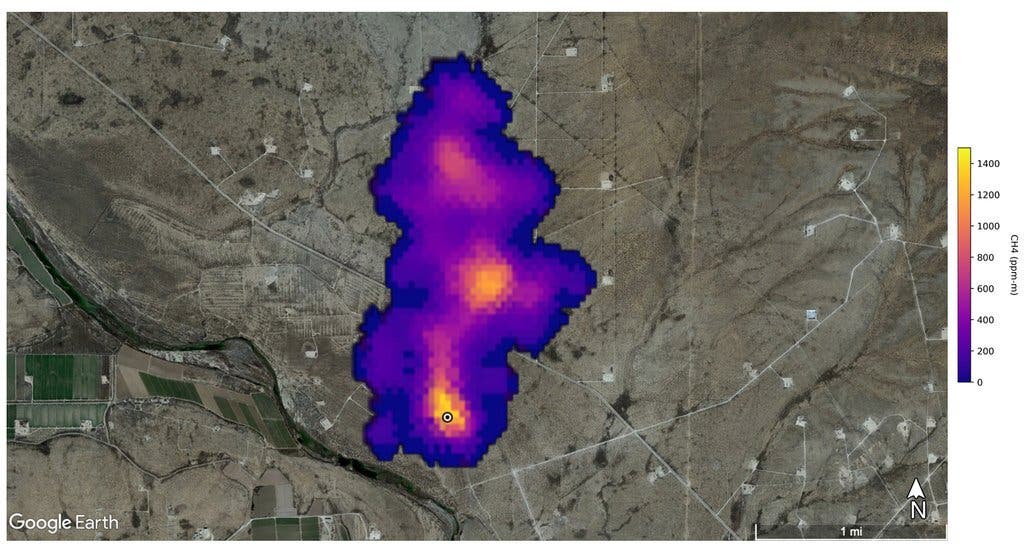An instrument created by the US Space Agency (NASA) has identified over 50 places on Earth that are releasing huge amounts of methane. While some of the hotspots were previously known, others have been newly discovered, including large landfill sites and oil and gas facilities. The tool also helps researchers assess the scale of the emissions.

Methane is a potent greenhouse gas, some 80 times more potent than CO2. But it’s also far more short-lived, which means that if we address methane pollution, we’ll see the improvements coming in relatively quickly.
NASA scientists created the device, called an imaging spectrometer, to study how airborne dust affects climate. But the instrument, installed in the International Space Station (ISS) in July, has also been able to detect the presence of methane. Circling Earth every 90 minutes from its perch aboard the ISS some 250 miles (420 kilometers high), EMIT can scan vast tracts of the planet dozens of miles across while fixing in on areas as small as a soccer field.
“This exciting new development will not only help researchers better pinpoint where methane leaks are coming from, but also provide insight on how they can be addressed – quickly,” NASA Administrator Bill Nelson said in a statement. EMIT is proving to be a critical tool in our toolbox to measure this potent greenhouse gas.”
Methane hotspots
While carbon dioxide (CO2) is the main culprit in the ongoing climate crisis, methane also accounts for an important fraction of human-caused greenhouse-gas emissions. While carbon dioxide is abundant and long-lived, methane’s effect is harder but shorter — so the sooner we can stop emitting methane, the better.
Methane is a natural component of the atmosphere but human activity has been adding massive amounts of it to the atmosphere. Oil and gas systems, landfills, and animal agriculture are the main sources of methane and overall, the gas is estimated to be responsible for about 30% of the global rise in temperatures to date.
Identifying the biggest methane point sources is a good way to start dealing with these growing emissions. With the information on the locations of the big emitters, we can take quicker action and prevent these emitters from continuing to spew methane into the atmosphere, NASA said.

So far, NASA has found major hotspots in the United States, the Middle East, and Central Asia. For example, NASA detected a plume about 2 miles (3.3 kilometers) long southeast of Carlsbad, New Mexico, in the Permian Basin. This is one of the largest oilfields in the world and covers parts of New Mexico and Texas. In Turkmenistan, EMIT identified a set of plumes from oil and gas infrastructure east of the Caspian Sea port city of Hazar.
Many hotspots are linked to the oil and gas industry, but not all. The researchers also uncovered a methane plume south of Tehran, Iran, about three miles (4.8 kilometers) long, from a waste-processing complex. They estimate flow rates of 40,300 pounds (18,300 kilograms) per hour at the Permian site and 111,000 pounds (50,400 kilograms) per hour in total for all the 12 Turkmenistan methane sources.
The emissions NASA uncovered greatly exceed what was expected and estimated in previous research.
“Some of the plumes EMIT detected are among the largest ever seen – unlike anything that has ever been observed from space,” Andrew Thorpe, a research technologist at JPL leading the EMIT methane effort, said in a statement. “What we’ve found in a just a short time already exceeds our expectations.”
If we want to truly address the climate crisis, we need systemic change at all levels of society, starting from how we grow and consumed food to how we heat homes and move around. But there’s no reason why we shouldn’t focus on the low-hanging fruit — and this is exactly what these methane plumes are: individual point sources of greenhouse gas emissions that can be addressed with relative ease.






